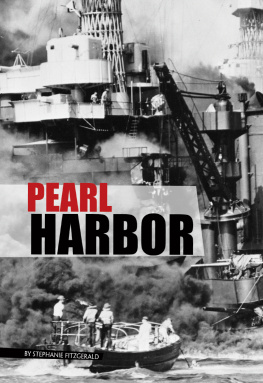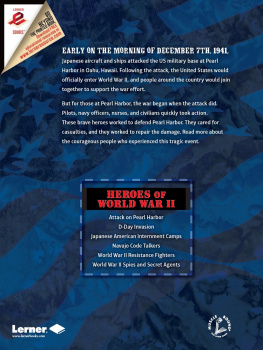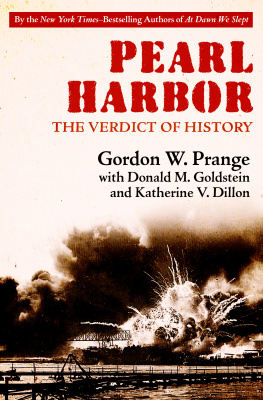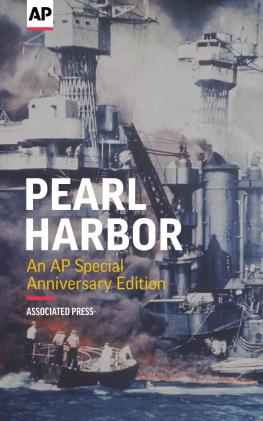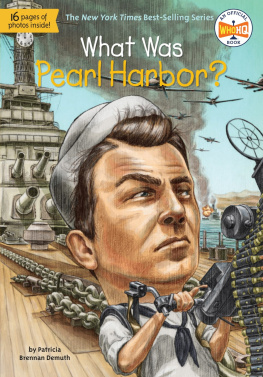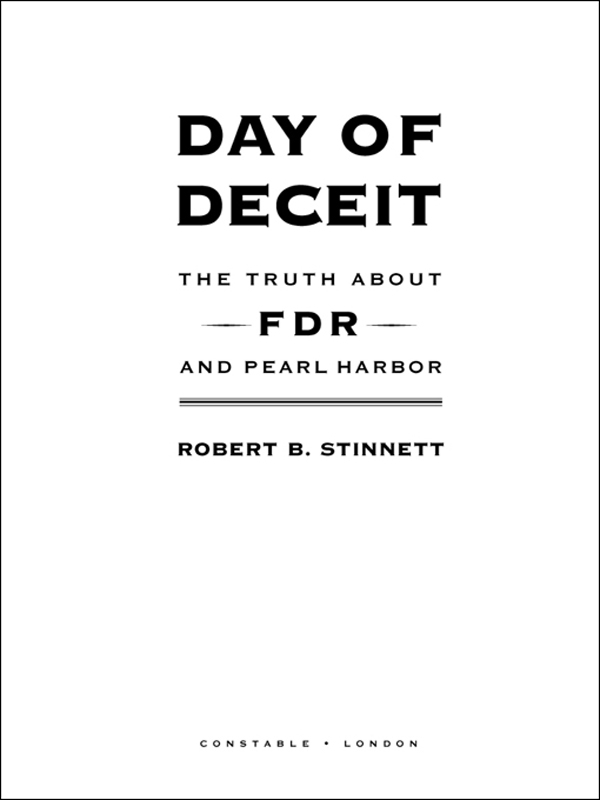PRINCIPAL CHARACTERS
The following are listed in the order of their appearance in the book. Rank/status is as of December 1, 1941.
FRANKLIN D. ROOSEVELT, President of the United States.
LIEUTENANT COMMANDER ARTHUR MCCOLLUM, Head, Far East Desk, Navy Intelligence, Washington.
REAR ADMIRAL WALTER S. ANDERSON, Commander of Battleships, Pacific Fleet.
ADMIRAL HUSBAND E. KIMMEL, Commander-in-Chief, Pacific Fleet.
VICE ADMIRAL JAMES O. RICHARDSON, former Commander-in-Chief, United States Fleet.
ADMIRAL HAROLD STARK, Chief of Naval Operations, Washington, DC.
ADMIRAL THOMAS HART, Commander-in-Chief, US Asiatic Fleet, Manila.
LIEUTENANT COMMANDER JOSEPH JOHN ROCHEFORT, Commander, Station HYPO, Pearl Harbor.
LIEUTENANT COMMANDER EDWIN LAYTON, Intelligence Officer, Pacific Fleet, Pearl Harbor.
ADMIRAL ISOROKU YAMAMOTO, Commander-in-Chief, Imperial Japanese Navy (Operational command).
ADOLF A. BERLE, JR., Assistant Secretary of State, Washington, DC.
J. EDGAR HOOVER, Director of Federal Bureau of Investigation.
COMMANDER VINCENT R. MURPHY, War Plans Officer for US Fleet.
LIEUTENANT GENERAL WALTER SHORT, Commander of US Armys Hawaiian Department, Fort Shafter, Oahu.
CHIEF RADIOMAN HOMER KISNER, Radio Traffic Chief, Station H, Oahu.
TADASHI MORIMURA, Assumed name of Japanese naval spy assigned to Hawaii, MarchDecember 1941. His true name, Ensign Takeo Yoshikawa.
LIEUTENANT GENERAL DOUGLAS MACARTHUR, Commander of Far East Forces, US Army, Manila.
COMMANDER LAURANCE SAFFORD, Officer-in-Charge, Station US.
AGNES MEYER DRISCOLL, Chief Civilian Navy Cryptographer at Station US.
GENERAL GEORGE MARSHALL, Chief of Staff (Operational Command) of US Army.
DUANE WHITLOCK, Radioman First Class. One of three radio traffic analysts at Station CAST.
LIEUTENANT COMMANDER THOMAS DYER. Chief Cryptanalyst, Station HYPO, Pearl Harbor.
PREFACE
T HIS BOOK CONTRADICTS AND QUESTIONS MUCH OF WHAT HAS BEEN written about the events and decisions that led to Japans attack on Pearl Harbor on December 7, 1941. My sole purpose is to uncover the true story of events leading up to the devastating attack on the naval base and adjoining Army facilities, and to document that it was not a surprise to President Franklin Delano Roosevelt and many of his top military and policy advisors.
This is an unvarnished account of how the United States got into a bloody conflict that threatened the free world. It is not an attempt to question the wisdom of Americas entry into the war.
As a veteran of the Pacific War, I felt a sense of outrage as I uncovered secrets that had been hidden from Americans for more than fifty years. But I understood the agonizing dilemma faced by President Roosevelt. He was forced to find circuitous means to persuade an isolationist America to join in a fight for freedom. He knew this would cost lives. How many, he could not have known.
The country was disillusioned by the failure of Americas idealistic commitment to make the world safe for democracy in World War I. Many Americans had chosen isolationism to shelter their young from the horrors of another war, and believed that Roosevelt would not send their sons to fight in foreign wars. Roosevelt believed that his countrymen would rally only to oppose an overt act of war on the United States. The decision he made, in concert with his advisors, was to provoke Japan through a series of actions into an overt act: the Pearl Harbor attack.
As I have discovered in the course of seventeen years of archival research and personal interviews with US Navy cryptographers, the answer to Roosevelts dilemma is found in an extraordinary number of documents whose release I have been able to obtain through Freedom of Information Act requests. These papers outline deliberate steps that were planned and implemented to elicit the overt action that catapulted America into the war, and devastated military forces at Pearl Harbor and other Pacific bases. Eight steps were suggested to provoke a Japanese attack. Shortly after reviewing these, Roosevelt put them into effect. After the eighth provocation had been taken, Japan responded. On November 27 and 28, 1941, US military commanders were given this order: The United States desires that Japan commit the first overt act. According to Secretary of War Henry L. Stimson, the order came directly from President Roosevelt.
There has been a controversy over American foreknowledge of the events of December 7, 1941. We have long known that Japanese diplomatic cableswhich pointed toward hostilitieswere intercepted and decoded. What I have discovered, however, is that we knew much more. Not only did we undertake provocative steps, we intercepted and decoded military cables. We knew the attack was coming.
By provoking the attack, Roosevelt accepted the terrible truth that Americas military forcesincluding the Pacific Fleet and the civilian population in the Pacificwould sit squarely in harms way, exposed to enormous risks. The commanders in Hawaii, Admiral Husband Kimmel and Lieutenant General Walter Short, were deprived of intelligence that might have made them more alert to the risks entailed in Roosevelts policy, but they obeyed his direct order: The United States desires that Japan commit the first overt act. More than 200,000 documents and interviews have led me to these conclusions. I am indebted to the Freedom of Information Act and its author, the late Congressman John Moss (D., CA) for making it possible for me to tell this story.

![Stinnett Day of deceit : the truth about FDR and Pearl Harbor ; [with a new afterword]](/uploads/posts/book/102803/thumbs/stinnett-day-of-deceit-the-truth-about-fdr-and.jpg)
